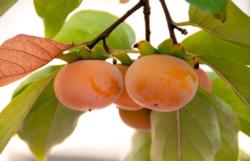Persimmon in California

Persimmon grows best in subtropical to mild-temperate climates, with moderate winters and mild summers (USDA hardiness zones 7-10). Persimmon has a low chilling requirement (less than 100 hours). As a result, the buds may break dormancy after periods of early warm spells, only to be damaged by spring frosts that occur later in the season. Trees do not produce well in regions with high summer heat, like the desert, because bark and fruit will sunburn. Although it can be grown in a wide range of soils, persimmon does not tolerate salinity (Farrar, 1999). The persimmon tree begins to bear fruit after 3 to 5 years and has an average life span of 60 years (Das et al., 2001).
California commercial cultivars ‘Hachiya’ and ‘Fuyu’ of D. kaki (oriental persimmon) can set seedless fruit without pollination (parthenocarpic) when no other pollinating varieties are nearby (LaRue, 1982). Cross pollination, and seed development within fruits, occurs in California when varieties are planted within half a mile of each other (Farrar, 1999). In the eastern and southern US, D. virginiana (American persimmon) requires pollination to set fruit. Parthenocarpy in persimmon varies by cultivar, region, climate, and nutritional status, and is not well understood (Woodburn and Andersen, 1996).

